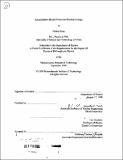| dc.contributor.advisor | Jacquelyn C. Yanch and Lee Grodzins. | en_US |
| dc.contributor.author | Song, Haijun, 1970- | en_US |
| dc.date.accessioned | 2010-01-07T20:46:26Z | |
| dc.date.available | 2010-01-07T20:46:26Z | |
| dc.date.copyright | 1998 | en_US |
| dc.date.issued | 1998 | en_US |
| dc.identifier.uri | http://hdl.handle.net/1721.1/50501 | |
| dc.description | Thesis (Ph.D.)--Massachusetts Institute of Technology, Dept. of Physics, 1998. | en_US |
| dc.description | Includes bibliographical references (p. 130-134). | en_US |
| dc.description.abstract | The feasibility of a new modality of radiation therapy, Accelerator-Based Neutron Brachytherapy (ABNBT), has been demonstrated through simulations and experimental work. The candidate nuclear reactions investigated are 9Be(d,n)'OB, 9Be(p,n)9B, and 7Li(p,n)7Be, with charged particle beam energies of less than 4.1 MeV. The focus of this work is the treatment of intracranial tumors which limits the diameter of the dose delivery needle tube to 6 mm. A prototype needle tube, a tube-in-tube design with cooling water running in between the inner and outer tubes to cool the beryllium target located at the tip of the inner tube, has been tested to a heat load near 150 Watts. The insertion length is 10 cm. The dosimetric characteristics were simulated using the Monte Carlo code MCNP and the treatment times were then calculated for a given heat load. The simulations and calculations show that the fast neutron dose is the dominant dose component for all the candidate reactions. The 9Be(d,n)oB reaction at Ed=1.5 MeV is capable of delivering a therapeutic dose of 66 RBE.Gy to the boundary of a 4.5 cm diameter tumor in 7.3 minutes at a heat load of 150 Watts. The other two candidate reactions deliver a similar dose rate at the same heat load to the target at a beam energy near 4.0 MeV. However, they show higher potential for dose enhancement with the boron-10 neutron capture reaction due to their soft neutron spectra. For input into dosimetric simulations, the source gammas from a thick beryllium target bombarded by a 1.5 MeV deuteron beam were measured at 600 with a 76 mm x 76 mm NaI(TI) detector. The prominent gammas range from 414 keV to 3.6 MeV. Dose distributions in a water phantom were measured with the prototype needle tube using the dual-ion chamber technique for the 9Be(d,n)10B reaction at Ed=1.5 MeV. The measurements and simulations agree within uncertainties. In conclusion this work has demonstrated the dosimetric desirability and the practical feasibility of ABNBT for the treatment of interstitial or intracavity tumors. | en_US |
| dc.description.statementofresponsibility | by Haijun Song. | en_US |
| dc.format.extent | 167 p. | en_US |
| dc.language.iso | eng | en_US |
| dc.publisher | Massachusetts Institute of Technology | en_US |
| dc.rights | M.I.T. theses are protected by
copyright. They may be viewed from this source for any purpose, but
reproduction or distribution in any format is prohibited without written
permission. See provided URL for inquiries about permission. | en_US |
| dc.rights.uri | http://dspace.mit.edu/handle/1721.1/7582 | en_US |
| dc.subject | Physics | en_US |
| dc.title | Accelerator-Based Neutron Branchytherapy | en_US |
| dc.title.alternative | ABNBT | en_US |
| dc.type | Thesis | en_US |
| dc.description.degree | Ph.D. | en_US |
| dc.contributor.department | Massachusetts Institute of Technology. Department of Physics | en_US |
| dc.identifier.oclc | 42283907 | en_US |
